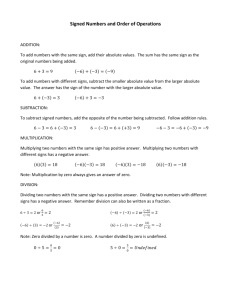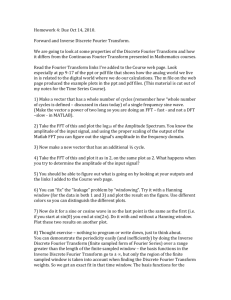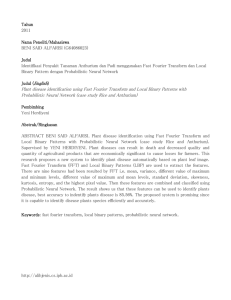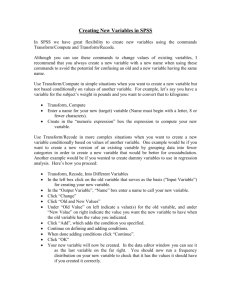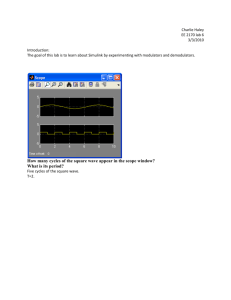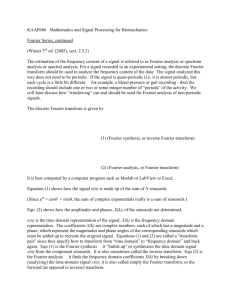FAST FOURIER TRANSFORM If N is a natural number, then let F N
advertisement
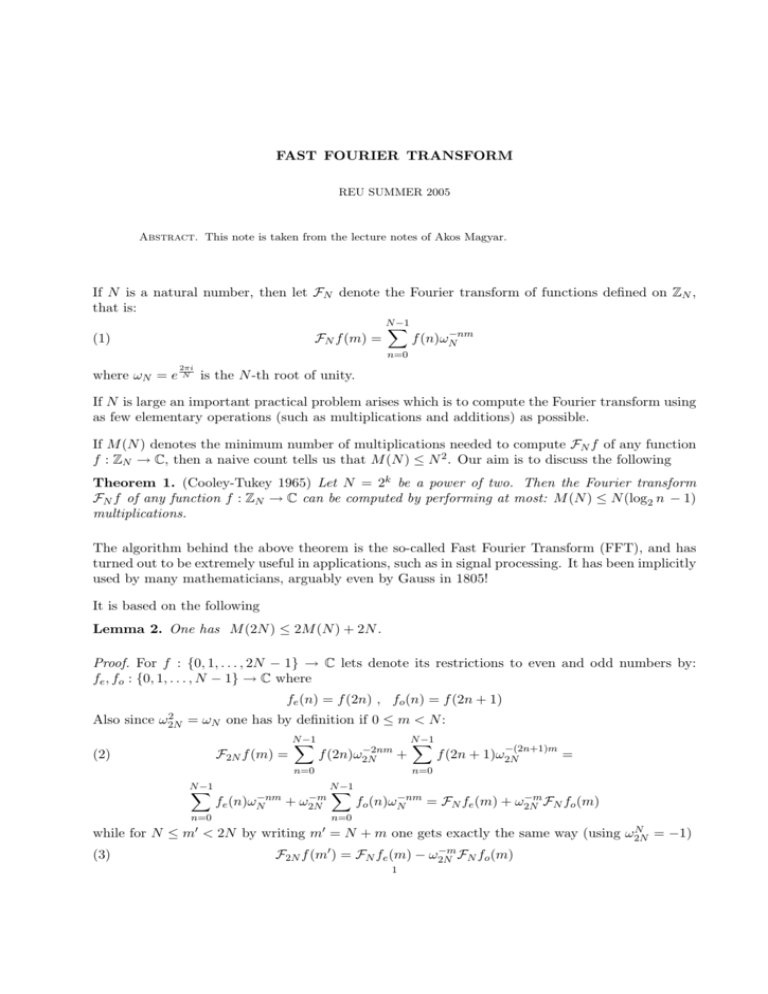
FAST FOURIER TRANSFORM
REU SUMMER 2005
Abstract. This note is taken from the lecture notes of Akos Magyar.
If N is a natural number, then let FN denote the Fourier transform of functions defined on ZN ,
that is:
N
−1
X
−nm
(1)
FN f (m) =
f (n)ωN
n=0
where ωN = e
2πi
N
is the N -th root of unity.
If N is large an important practical problem arises which is to compute the Fourier transform using
as few elementary operations (such as multiplications and additions) as possible.
If M (N ) denotes the minimum number of multiplications needed to compute FN f of any function
f : ZN → C, then a naive count tells us that M (N ) ≤ N 2 . Our aim is to discuss the following
Theorem 1. (Cooley-Tukey 1965) Let N = 2k be a power of two. Then the Fourier transform
FN f of any function f : ZN → C can be computed by performing at most: M (N ) ≤ N (log2 n − 1)
multiplications.
The algorithm behind the above theorem is the so-called Fast Fourier Transform (FFT), and has
turned out to be extremely useful in applications, such as in signal processing. It has been implicitly
used by many mathematicians, arguably even by Gauss in 1805!
It is based on the following
Lemma 2. One has M (2N ) ≤ 2M (N ) + 2N .
Proof. For f : {0, 1, . . . , 2N − 1} → C lets denote its restrictions to even and odd numbers by:
fe , fo : {0, 1, . . . , N − 1} → C where
fe (n) = f (2n) , fo (n) = f (2n + 1)
2 = ω one has by definition if 0 ≤ m < N :
Also since ω2N
N
F2N f (m) =
(2)
N
−1
X
−2nm
f (2n)ω2N
+
n=0
N
−1
X
while for N ≤
(3)
n=0
m0 <
−nm
−m
fe (n)ωN
+ ω2N
N
−1
X
−(2n+1)m
f (2n + 1)ω2N
=
n=0
N
−1
X
−nm
−m
fo (n)ωN
= FN fe (m) + ω2N
FN fo (m)
n=0
2N by writing
m0
N = −1)
= N + m one gets exactly the same way (using ω2N
−m
F2N f (m0 ) = FN fe (m) − ω2N
FN fo (m)
1
2
REU SUMMER 2005
Now to compute FN fe and FN fo , one needs 2M (N ) multiplications and then 2N additional multi−m
−m
plications are needed to compute ω2N
and the products ω2N
FN fo (m). This proves the lemma. Proof of Theorem1. Let N = 2k and proceed by induction on k.
For k = 1 one has: F2 f (0) = f (0) + f (1) and F2 f (1) = f (0) − f (1) so M (2) = 0
For the induction step k → k + 1 one has by the above lemma:
M (2k+1 ) ≤ 2M (2k ) + 2k+1
M (2k )
M (2k+1 )
≤
+1≤k−1+1=k
k+1
2K
2
and this is what we wanted to show.
Next we discuss a “cheap” way of multiplying polynomials of large degree and also large numbers
using the FFT.
P
P
m
Let p(x) = Pn=0 an xn and q(x) = Q
m=0 bm x Pbe polynomials of degrees P and Q. Then their
k
product r(x) = p(x)q(x) is of the form: r(x) = R
k=0 ck x with R = P + Q and for 0 ≤ k ≤ R one
has
X
(4)
ck =
an bk−n where 0 ≤ n ≤ P and 0 ≤ k − n ≤ Q
n
Again a by naive count, to compute the coefficients ck one would first compute all the products
an bm using (P + 1)(Q + 1) multiplications. The idea is that formula (4) looks like the convolutions
of functions on ZN which is transformed into point-wise multiplication by the Fourier transform.
Let N be a power of 2 such that: P + Q < N
by:
an
f (n) =
0
and similarly
bm
g(m) =
0
Then it is easy to check that
≤ 2(P + Q) and define the functions: f, g : ZN → C
if 0 ≤ n ≤ P
if P < n ≤ N − 1
if 0 ≤ n ≤ Q
if Q < n ≤ N − 1
ck = f ∗ g(k) =
N
−1
X
f (n)g(k − n)
n=0
Note that the difference k−n is computed in ZN that is (mod N), so if k < n then k−n := N −(n−k).
Using the fact that: f[
∗ g(m) = fˆ(m)ĝ(m) one computes the convolution f ∗ g by applying the
FFT twice to get fˆ and ĝ, then using N multiplications one gets f[
∗ g and by one more application
of the FFT gives f ∗ g. Thus we have
Corollary 3. The product polynomial r(x) = p(x)q(x) can be computed by using no more than
(5)
multiplications, where N ≤ 2(P + Q).
M ≤ 3N log2 N − 2N



